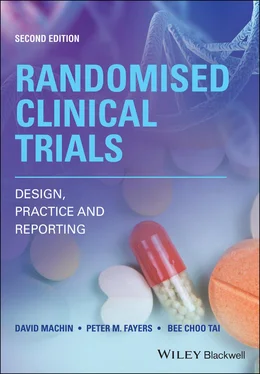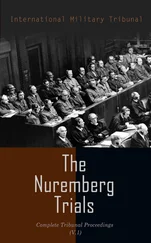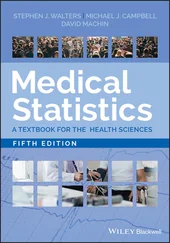3.9.1 Assessments
At some place in the protocol, an overview of the critical stages in patient management and key points of assessment needs to be provided. At each of these assessments, whether at the first presentation of the consenting individual before randomisation, post‐randomisation at visits when active treatment will be given, or for visits merely for check‐up purposes, the precise details of what examinations should be made and the details to be recorded (on the trial data forms) must be indicated. In SQCP01 (2006) even those children with cleft palate randomised to delayed surgery will have the same assessment schedule as those randomised to immediate surgery as these time points represent important milestones in, for example, their speech development.
Example 3.18 Protocol SQCP01 (2006): Comparing speech and growth outcomes between two different techniques and two different timings of surgery in the management of clefts of the secondary palate
Method
Infants will be recruited at age less than 12 months and followed up until 17 years of age. They will be assessed at age 18 months, 3, 5, 7, 9, 15 and 17 years.
The PRESSURE (2000) trial lists the sequences of assessments under different headings, and for each provides details of precisely what is required. We have indicated these headings in Example 3.19but only for their section 8.2.3 have we specified the details. The number of assessments depends on whether or not the patient has, or subsequently develops, pressure sores and also on how long they remain in the hospital ward. As one would expect, this contrasts markedly with SQCP01 (2006) which stipulates seven assessment times scheduled at various growth and speech development stages of the children.
Example 3.19Protocol PRESSURE (2000): Pressure‐relieving support surfaces: a randomised evaluation
8. ASSESSMENTS AND DATA COLLECTION
8.1 Registration and randomisation
8.2 Post randomisation assessments
8.2.1 Immediate
8.2.2 Daily
8.2.3 Twice weekly up to 30 days and then weekly up to 60 days
The research nurse or designated ward nurse will record the following details twice weekly up to 30 days and then weekly up to 60 days or trial completion/withdrawal:
Skin assessment (sacrum, buttocks, heels and hips) using the skin classification scale.
Mobility/activity/friction and shear/moisture/nutrition/sensory perception scores using Braden scale.
Mattress checklist including: manufacturer, model, model number, type of mattress and confirmation that the mattress is alternating and working correctly. If the mattress has been changed by ward staff the reason for the change will be documented.
Seating provision including model of chair or cushion
Confirm continued eligibility
8.2.4 Weekly up to 60 days
8.2.5 Patients with pressure sores
8.2.6 At trial completion/and or discharge
In contrast to the previous section, here the precise details of the items required at each assessment should be specified. The items might not be listed exhaustively but are often indicated by reference to the trial forms with a set of specimen forms bound into the protocol. In PRESSURE (2000), skilled personnel were trained about detailed aspects of the protocol, including the examination and documentation procedures. Whenever possible, it is important to complete the documentation as the examination proceeds. Investigators should not rely on making routine clinical notes and sometime later completing the trial‐specific forms, as the notes will not have been designed for trial‐specific purposes and important items may be omitted. The protocol should make clear which form or forms are applicable for each assessment – so numbering the different trial forms in a logical manner is important for this. We return to data collection forms in Section 3.14below and give some examples in Chapter 4.
3.10 Statistical considerations
The principal tasks of the statistical team before formulating this section is to debate with the clinical teams’ issues relating to the final sample size chosen for the trial and to describe the main features of the subsequent analysis once the data are in hand. Straightforward statistical methods are preferable but not always feasible. The methods should be explained in lay terms and with appropriate, both accessible and understandable, reference material.
3.10.1 Number of subjects
The number of subjects required will depend on the hypotheses to test, the trial design, the type of endpoint variables and whether or not characteristics of the patients themselves need to be taken into account. An important consideration when deciding the eventual trial size is whether such a recruitment target can be achieved in a reasonable time frame. In many instances, developing teams are overly optimistic in this regard.
Although some details of the trial size process are somewhat routine, in that conventional wisdom dictates that the (two‐sided) test size is set minimally at 5% and the power minimally at 90%, other details such as the anticipated effect sizes should be the subject of long discussion amongst the protocol development team. Neither should they accept the conventional wisdom just indicated without debate. Test size is discussed in Chapters 8and 9and power in Chapter 9.
Example 3.20 Protocol SQGL02: Brimonidine as a neuroprotective agent in acute angle‐closure glaucoma (AACG)
9. STATISTICAL CONSIDERATIONS
Trial size
For sample size determination, it is anticipated that approximately 80% of patients receiving Timolol will experience visual field loss progression at 3 months post laser PI. With the hope that the proportion of Brimonidine treated patients having visual field loss progression will be reduced to 40%, a two‐sided test, with 5% level of significance and power of 90% would require recruitment of 30 patients in each arm (Machin, Campbell, Fayers & Pinol, 1997 1 ).
It is anticipated that after randomisation, 10% of the AACG patients may not respond to the initial medical treatment, and will require surgery instead of laser PI, and thus will not continue in the trial. After PI, it is expected that a further 10% of patients may not complete the trial and may withdraw from the study (see Withdrawal from Treatment ). Taking into consideration the patients expected to fall out at each stage, we thus require approximately 80 AACG patients (40 patients per treatment group) for the trial.
1 Now updated as Machin, Campbell, Tan and Tan (2018).
In this example, the protocol takes note of patient losses due to a relatively large proportion expected to need surgery (rather than laser peripheral iridotomy, PI) and compensates by adjusting upwards the number of patients to recruit. They do not stipulate; however, how these patients will be dealt with in the final analysis and reporting. One option is to regard all these as failures when calculating the proportions in each group with visual field loss at 3 months post PI.
An alternative design possibility would have been to randomise patients after successful PI, so as to avoid recruiting patients who will provide little information on the relative merits of Timolol and Brimonidine. However, the design team may have discussed this (as well as other options) and rejected this for good reasons.
As with determining the trial size, the format of the analysis will depend on the type of questions being posed, the trial design, the type of endpoint variables and whether or not characteristics of the patients themselves need to be taken into account. If there is only a single endpoint concerned, then the plan for the subsequent analysis may be described rather succinctly except in circumstances where the analysis may be unusual in format. In some situations, several endpoints will be included so that a careful description of the analytic approach for each needs to be detailed. In these circumstances, multiple statistical tests may be concerned and cognisance of that may need to be taken into account.
Читать дальше












